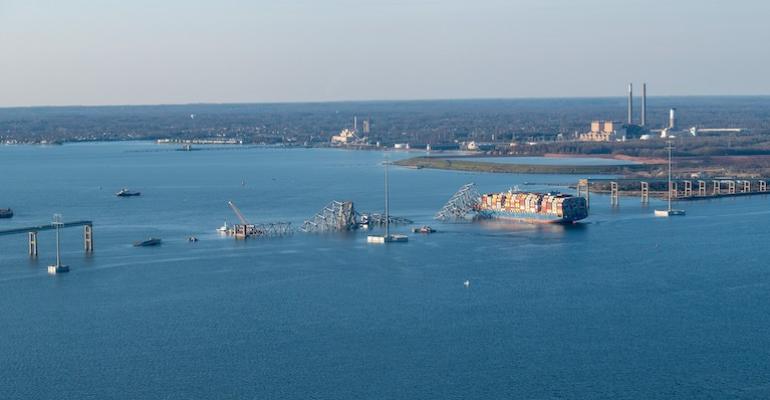When a huge container ship collided with a bridge in Baltimore last month, causing the complete collapse of one of the city’s main harbour crossings and bringing shipping in the area to an abrupt halt, the world’s shipping industry winced. This deadly tragedy not only brought a port that sees $80 billion in annual trade to a stop, it revealed a worrying vulnerability in the US’s port and shipping infrastructure, which currently has more than 300 unprotected bridges.
Bigger vessels, smaller crews
What led to the catastrophic collapse in Baltimore? Some speculate that dirty fuel cut power to the MV Dali’s engine. There are of course some absurd conspiracies out there too – but one fact that has emerged is that such incidents have been predicted in the shipping industry for decades.
This is attributed to the fact that ships are getting bigger, and their crews are getting smaller. Container ships in the 1970s carried around 1,000 containers. Today these massive vessels carry up to 24,000 containers and are managed by a scant crew. And, in the event of a collision, the ageing infrastructure built at and around ports half a century ago will always lose. This, combined with the fact that only about a third of US bridges have some sort of protection, implores Asian leaders to ask themselves: How resilient is Asia’s port infrastructure?
Strategic Straits
While China is home to most of the world’s busiest ports, Singapore’s strategic location makes a great case study for the value of resilience. The country’s iconic skyline overlooks one of the busiest shipping lanes in the world, with hundreds of ships anchored off the island waiting to berth. Last year, the world’s second busiest port handled close to 40 million containers, making The Little Red Dot absolutely strategic to world trade. Singapore is also innovating rapidly, building the world’s first fully-automated container port that will handle some 65 million containers a year when it launches in 2040. While this megaport is in a distant corner of the country, far from any critical infrastructure and no doubt built to handle today and tomorrow’s ever-more obese ships, back in town there is evidence that the city state takes resilience very seriously.
Alongside Singapore’s Marina Barrage, a dam wall that separates some of the island’s precious freshwater reserves from a crowded sea, an imposing barrier made of heavy steel lurks just beneath the surface. Presumably to stop vessels from colliding with the barrage, this structure clearly illustrates the island’s stance when it comes to protecting itself - a collision here would be unlikely to bring global trade to its knees as the Suez canal was blockage did in 2021 – costing global trade $400 million per hour. Singapore has other ways to protect its waters, but the risks are mostly not related to infrastructure failures or collisions but to conflict and environmental risks. The country is also deploying an artificial intelligence (AI)-driven vessel management system to predict collisions early and proactively manage traffic conditions.
More broadly, Asia, which is currently the motor of the global economy, has the most to lose if a major port in the region is disrupted. According to a recent United Nations report, while Asia’s low-capacity and often outdated port infrastructure is not as resilient as it should be, a major disruption to global trade is unlikely to be caused by these smaller ports not located in critical bottlenecks like the Suez Canal, where one stranded ship can very quickly wreak economic carnage. Fortunately, however, the region’s megaports are relatively young, built to modern specifications to accommodate newer, larger ships with robust deep water ports, diverse routes, and better-connected specialist terminals in openly accessible areas.
With the world’s largest, busiest, and fastest-growing ports, authorities across Asia must urgently reassess the strength of their infrastructure and use every tool in the chest to build resilience as trade accelerates. And, as in most industries, data rules.
The details are in the data
Given the increased vulnerability to global trade as ships get bigger, companies should be using data to proactively identify risks to infrastructure, assess their impact, and formulate strategies to mitigate and even predict disruptions. The maritime industry worldwide increasingly relies on data analytics to streamline operations, boost efficiency, and fortify security. Fortunately, ports are transforming digitally to remain competitive as risk evolves, integrating data analytics and AI into port and ship operations and unlocking higher levels of efficiency, security, as well as sustainability.
And as ports tackle modern trade challenges like larger ships and busier routes, data analysis and AI enable informed decision-making and optimized, safer operations. Data also enables smarter, more interconnected, efficient, and most importantly resilient ports. For example, we worked with Van Oord to develop the world’s first tool that allows cross filtering between traditionally siloed disciplines: flood protection and nature conservation. This helped companies of all sizes including the World Bank, local communities, NGOs, governments and companies like us to reduce the time taken to identify priority hotspots from months to just a few minutes.
Disasters like the Baltimore bridge collapse are a wake-up call for authorities to better understand their infrastructure and better manage their ports. This means breaking down data silos and embracing trusted end-to-end data analytics platforms that make understanding a port’s operations and resilience easy. By leveraging data-driven insights, port operators can better understand their vulnerabilities, and build better, more resilient infrastructure capable of preventing or at least withstanding unforeseen events like collisions.
While physical barriers like those at Singapore’s Marina Barrage are certainly required and reassuring, in an age of growing complexity and expanding risks from bigger, more frequent ships, knowledge is a short-cut to resilience supported by data.
Copyright © 2024. All rights reserved. Seatrade, a trading name of Informa Markets (UK) Limited.
Add Seatrade Maritime News to your Google News feed.  |

